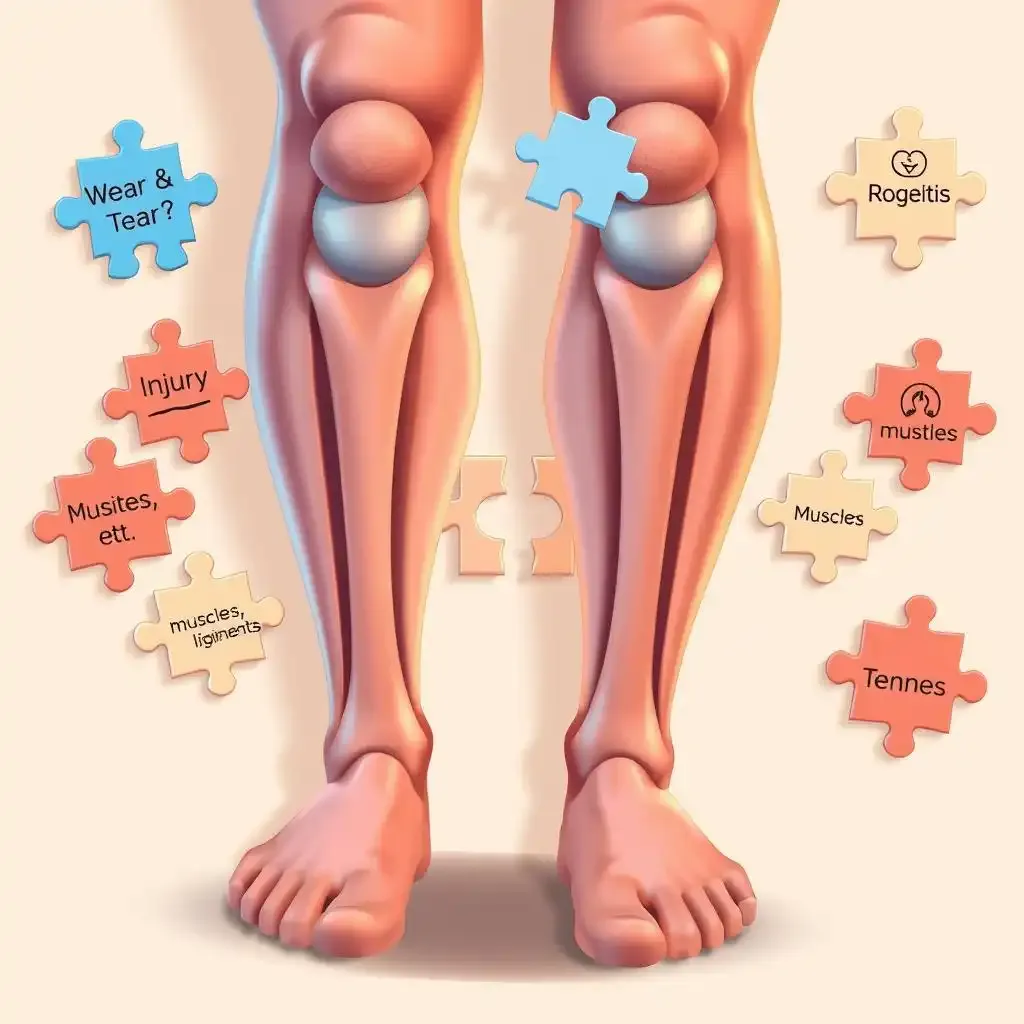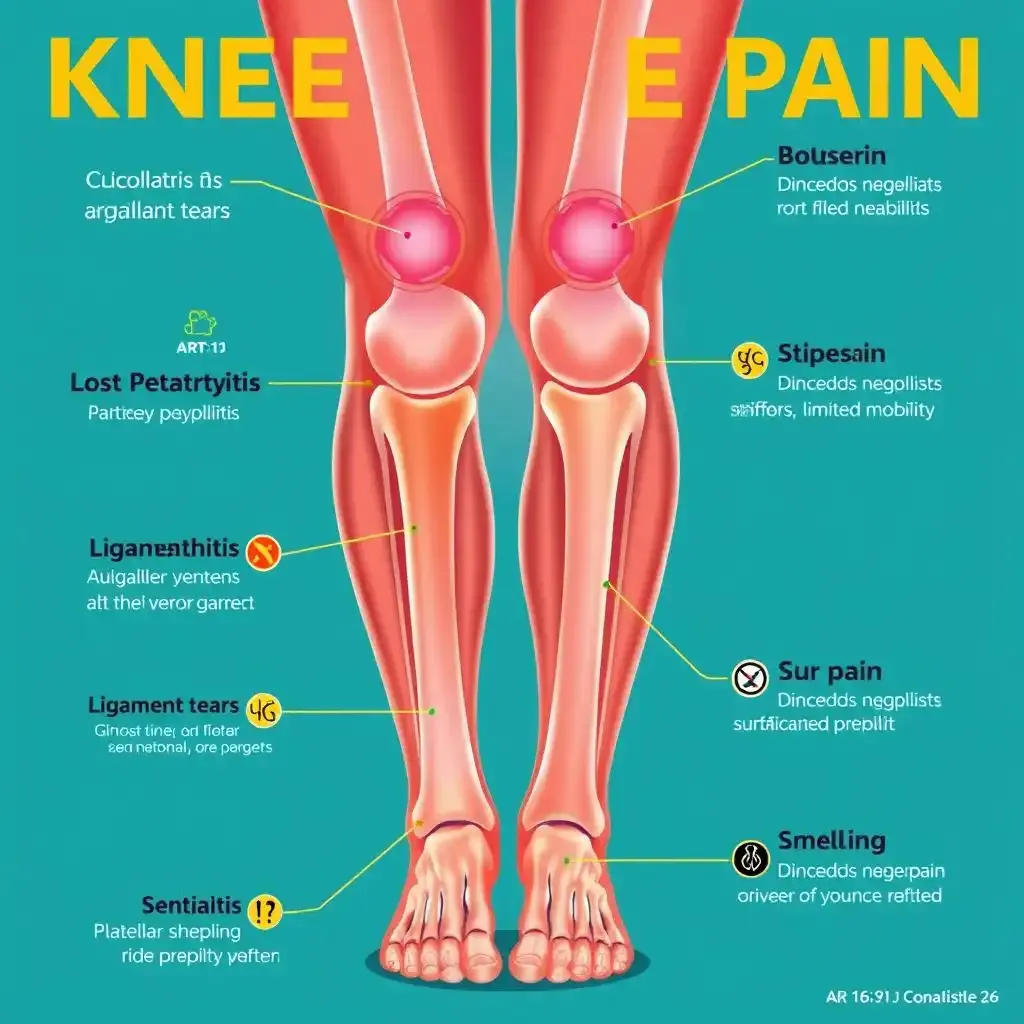Table of Contents
So, your knees are in pain? You're not alone! Many people experience knee pain at some point in their lives. It can range from a mild ache to a sharp, stabbing pain, making everyday activities difficult. This article, created by kizworld, aims to help you understand why your knees might be hurting and what you can do about it. We'll explore common causes of knee pain, from the everyday wear and tear of aging to more serious injuries and conditions. We'll also look at various treatment options, from simple self-care strategies to medical interventions. Remember, this information is for general knowledge and shouldn't replace a doctor's advice. If your knee pain is severe or persistent, it's crucial to seek professional medical help. Let's explore in and get to the bottom of those aching knees!
Cause of Knee Pain | Symptoms | Treatment Options |
|---|---|---|
Aging | Mild to moderate pain, stiffness | Physical therapy, pain relievers, low-impact exercise |
Injury (e.g., sprain, tear) | Sharp pain, swelling, instability | Rest, ice, compression, elevation (RICE), medical attention |
Arthritis (e.g., osteoarthritis, rheumatoid arthritis) | Pain, stiffness, swelling, limited range of motion | Medication, physical therapy, joint replacement surgery |
Repeated Stress | Gradual onset of pain, stiffness | Rest, ice, modification of activities, strengthening exercises |
Infection | Swelling, redness, warmth, fever | Antibiotics, medical attention |
Mechanical Problems (e.g., misalignment) | Pain, clicking or popping sounds | Physical therapy, bracing, surgery |
Understanding Why Your Knees Are in Pain
Understanding Why Your Knees Are In Pain
Okay, so your knees are complaining, huh? It's like they're little grumpy gremlins living inside your legs, constantly muttering about how much they hate your life choices. But before you start planning a knee-replacement party, let's figure out what's actually going on. Think of your knees as incredibly complex hinges – amazing pieces of engineering that let you walk, run, jump, and even do that super-cool moonwalk you've been practicing. But like any hinge, they can get worn out, damaged, or just plain irritated. Maybe you've overdone it at the gym, twisted your knee awkwardly, or maybe it’s just plain old age catching up. Old age! The villain we all secretly fear. It's a bit like a car – if you don't maintain it properly, things start to break down. Same goes for your knees. The slightest injury could make your knees feel like they're protesting against your existence.
Possible Culprit | What it Feels Like | What to Do |
|---|---|---|
Wear and Tear (Osteoarthritis) | Aching, stiffness, especially after rest | Gentle exercise, stretches, maybe some pain relief from your doctor |
Injury (Sprain, Tear) | Sharp pain, swelling, trouble moving your knee | RICE (Rest, Ice, Compression, Elevation), see a doctor ASAP! |
Bursitis | Pain and swelling on the sides of your knee | Rest, ice, maybe some anti-inflammatory meds (check with your doctor!) |
Sometimes, the pain isn't even directly *in* your knee joint. It could be the muscles, tendons, or ligaments around it. It’s a bit like a puzzle; you need to find the right piece to solve your knee issue. Imagine your knee as a team – if one player (muscle, tendon, etc.) is injured, it can mess up the whole team. This can lead to pain that seems to come from your knee, even if the actual problem is somewhere else. It's sneaky like that.
- Overuse (too much running, jumping)
- Lack of exercise (weak muscles make your knees work harder)
- Bad posture (puts extra stress on your knees)
- Being overweight (more weight = more stress on your knees)
My grandma used to say, "A stitch in time saves nine." That’s especially true with knee pain. Catching problems early is way easier than dealing with a major issue later on. It's like dealing with a tiny crack in your wall; ignore it, and you'll end up with a major problem. If you ignore your knee pain, you'll be sorry!
"Listen to your body. It’s always trying to tell you something." - Unknown Wise Person
Common Causes of Knee Pain and Their Symptoms
Common Causes Of Knee Pain And Their Symptoms
The Usual Suspects: Wear and Tear and Injuries
Let's be honest, our knees take a beating. They're the shock absorbers for our entire body weight, constantly bending and straightening. It's like they're the unsung heroes of our daily lives. Over time, this constant use can lead to wear and tear, especially as we get older. Think of it like a really old pair of jeans – after years of use, they're going to show some wear and tear. This wear and tear can manifest as osteoarthritis, a type of arthritis that causes pain, stiffness, and swelling in the knee joint. Ouch! And injuries? Well, a sudden twist, a fall, or a clumsy move can easily damage the ligaments, tendons, or menisci in the knee, resulting in pain, swelling, and even instability. It's like dropping your phone – sometimes it's just a crack, sometimes it's completely shattered.
Type of Pain | Possible Cause | What it Feels Like |
|---|---|---|
Aching, Stiffness | Osteoarthritis | Pain that's worse after rest or inactivity. |
Sharp Pain, Swelling | Ligament or Meniscus Tear | Sudden, intense pain, often with swelling and difficulty moving the knee. |
I remember when I was younger, I was super into skateboarding. I had a few pretty spectacular wipeouts, and let me tell you, my knees took the brunt of it! One time, I landed wrong, and I spent the next week hobbling around like a penguin. It was not fun, but it taught me a valuable lesson about respecting my knees. So, be careful out there! Treat your knees like you would a precious antique — with care and respect.
Beyond the Joint: Muscles, Tendons, and More
Knee pain isn't always about the knee joint itself. Sometimes, the problem stems from the muscles, tendons, or ligaments surrounding it. Think of your knee as a team – if one player (a muscle or tendon) is injured, it can throw the whole team off balance and cause pain that feels like it's coming from your knee. It's like a domino effect. For example, patellar tendinitis, often seen in athletes, causes pain just below the kneecap due to inflammation of the tendon. Bursitis, another common culprit, is inflammation of the small fluid-filled sacs (bursae) that cushion the knee joint. This can lead to pain and swelling on the sides of the knee. It’s a sneaky little problem, often causing unexpected pain.
- Patellar Tendinitis: Pain below the kneecap, often from overuse.
- Bursitis: Pain and swelling on the sides of the knee, from inflammation of the bursae.
- IT Band Syndrome: Pain on the outer side of the knee, due to tightness in the iliotibial band.
It's important to remember that knee pain can have many causes. What works for one person might not work for another. That's why it's so important to see a doctor or physical therapist if your knee pain is persistent or severe. They can help you figure out what's going on and create a plan to get you back on your feet (literally!).
Sneaky Stuff: Arthritis and Other Conditions
Sometimes, the cause of your knee pain is a bit more complex. Arthritis, for instance, is a common cause of knee pain, especially osteoarthritis (wear and tear arthritis) and rheumatoid arthritis (an autoimmune disease). Arthritis can cause pain, stiffness, swelling, and limited range of motion in the knee. It's like having a really grumpy roommate who constantly complains and makes it hard to move around. Other conditions, such as infections or mechanical problems (like a misalignment of the kneecap), can also cause knee pain. These problems can be tricky to diagnose and require expert medical attention.
"The knee is a complex joint, and knee pain can have many causes. Proper diagnosis and treatment are essential." - Dr. (insert name of a reputable doctor or physical therapist here)
This is where things get serious. If you suspect arthritis or another serious condition, don't mess around. Get to a doctor. Seriously. Early diagnosis and treatment are key to preventing long-term problems and maintaining your knee health. Think of it as getting your car checked out before it completely breaks down – much less stressful and expensive in the long run.
Treating and Preventing Knee Pain
Self-Care Strategies: Your First Line of Defense
Okay, so your knees are acting up. Don't panic! Before you start thinking about fancy surgeries or expensive treatments, let's try some simple self-care stuff. Think of your knees like a temperamental pet – they need a little TLC to be happy. First, rest! Avoid activities that aggravate your pain. It's like giving your knees a timeout – they need a break to recover. Next, ice those bad boys! Ice packs reduce swelling and inflammation, which is like giving your knees a soothing hug. Apply ice for 15-20 minutes at a time, several times a day. It's like a mini-spa treatment for your knees. Compression is another good idea – a knee sleeve helps support your knee joint and reduces swelling. It's like giving your knee a comforting hug. And finally, raise your knees. Keep your knees above your heart whenever possible – this helps reduce swelling. It's like giving your knees a little lift, helping them feel better. Remember, consistency is key with self-care! Small, regular actions will make a difference over time.
Self-Care Method | How it Helps | How Often |
|---|---|---|
Rest | Reduces stress on the knee | As needed |
Ice | Reduces swelling and inflammation | 15-20 minutes, several times a day |
Compression | Supports the knee joint | Throughout the day |
Elevation | Reduces swelling | Whenever possible |
Seeking Professional Help: When Self-Care Isn't Enough
Sometimes, self-care isn't enough. If your knee pain is severe, persistent, or accompanied by other symptoms (like fever or redness), it's time to see a doctor. Don't be a hero – ignoring a problem will only make it worse. Think of it like a leaky faucet – a small drip can turn into a flood if you don't fix it. A doctor can diagnose the underlying cause of your pain and recommend appropriate treatment. This might involve medication (like anti-inflammatory drugs or pain relievers), physical therapy, or even surgery in some cases. Physical therapy is like a personal trainer for your knees – a therapist will teach you exercises to strengthen the muscles around your knee, improve flexibility, and restore function. And if all else fails, surgery might be necessary. It's a last resort, but sometimes it's the best option for fixing a seriously damaged knee. It's like a major car repair – it's expensive and time-consuming, but it's the only way to get your knee back to top condition.
- See a doctor if you're in a lot of pain or if your pain is severe.
- Physical therapy can help strengthen the muscles around your knee.
- Surgery is a last resort, but it's sometimes needed for severe knee problems.
"Prevention is better than cure." - An ancient proverb (and it's true!)
Final Thought
Dealing with knee pain can be frustrating, but understanding the potential causes and available treatments empowers you to take control. Remember to listen to your body, prioritize self-care, and seek professional help when needed. By proactively addressing knee pain, you can maintain mobility and enjoy a more active life. Remember to consult your doctor or physical therapist for personalized advice personalized to your specific situation. Remember, kizworld is here to support you on your process to healthier knees.